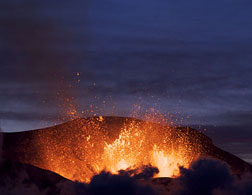Explainer's Big-Ash Roundup
How do you pronounce Eyjafjallajökull? Why can't planes fly beneath an ash cloud? And more.
An ash cloud from the eruption of a volcano beneath Iceland's Eyjafjallajökull glacier shut down airports across Northern and Central Europe on Thursday and Friday. Forecasters predict the cloud will continue to snarl air traffic at least through the weekend, and Cathay Pacific is advising passengers to delay nonessential travel to Europe until next month. Fallout from the ash incident raises a number of questions, answered herewith.
On Thursday night, the ash cloud extended from an altitude of 18,000 feet to 35,000 feet above sea level. Why couldn't airlines fly their jets beneath the cloud, rather than canceling all flights?
Because even a little ash is bad for a plane. It's easier to define the top of an ash cloud than the bottom, as larger ash particles tend to drift downward before the finer bits. As a result, the visible bottom of the haze may be at 18,000 feet, but there's still plenty of ash hanging in the air beneath. Those lower-density, lower-altitude particles can easily damage the rotors and engines of a passenger jet.
Flying above an ash cloud isn't a great idea, either. While the pilot can be fairly confident he won't encounter many dangerous bits of frozen lava up there, an emergency landing would be virtually impossible if anything else went wrong.
The Volcanic Ash Advisory Center in London has been issuing advisories on the status of the ash cloud. How often does a Volcanic Ash Advisory Center spring into action?
Somewhere between almost never and several times a day, depending on its territory. There are nine Volcanic Ash Advisory Centers worldwide—in London; Toulouse, France; Anchorage, Alaska; Washington, D.C.; Montreal; Darwin, Australia; Wellington, New Zealand; Tokyo; and Buenos Aires, Argentina—each with a mandate to protect aviators from potentially deadly ash clouds. When a cloud appears, the nearest center issues an advisory predicting its movement, density, and duration. Updates are issued every six hours for as long as the ash hangs in the air. That can range from less than a day to more than a year, depending on the height of the cloud and the size of the particles. The two busiest centers are in Darwin and Washington (whose territory includes Ecuador's volcano alley); together they issue between 2,000 and 4,000 advisories per year. Other centers might go an entire year without issuing a local bulletin. The researchers aren't bored, though. They also monitor tropical storms, flash flooding, wildfires, and oil spills.
Each center monitors its assigned area using satellite imagery and tips from meteorologists and vulcanologists. Some units also search messages between pilots, air-traffic controllers, and relevant government agencies for words like ash, eruption, volcano, or ceniza (the Spanish word for ash).
How will the Icelandic eruption affect the climate?
Probably not significantly, but it's too early to say. The ash and sulfur dioxide ejected in a volcanic eruption can block the sun's rays from reaching the earth. The most important predictors of how much an eruption will impact the weather are ash volume, column height, and duration. These three factors help determine where an eruption falls on the Volcanic Explosivity Index, which runs from 0 ("non-explosive") to 8 ("mega-colossal"). We don't know how the Icelandic eruption will score, but volcanoes in the area rarely clear a 1 ("gentle").
Even so, Eyjafjallajökull could affect the climate. If the eruption lasts a very long time, like Iceland's eight-month Laki fissure eruption in 1783, it might create a noticeable cooling effect. Laki ejected more lava than any eruption in modern times and caused a major famine in Europe. Benjamin Franklin, who was in Paris at the time, may have been the first person to figure out that volcanic ash could block out the sun and lower the temperature. Some scientists are afraid that the explosion could also trigger an eruption of the nearby—and much larger—Katla volcano, which is several years overdue.
How do you pronounce Eyjafjallajökull?
Very carefully. Here's a recording of someone from the Icelandic Embassy pronouncing the word:
Got a question about today's news? Ask the Explainer.
Explainer thanks Karen Harpp of Colgate University, Davida Street of the Washington Volcanic Ash Advisory Center, and Paul Takemoto of the FAA.
Become a fan of Slate on Facebook. Follow us on Twitter.
